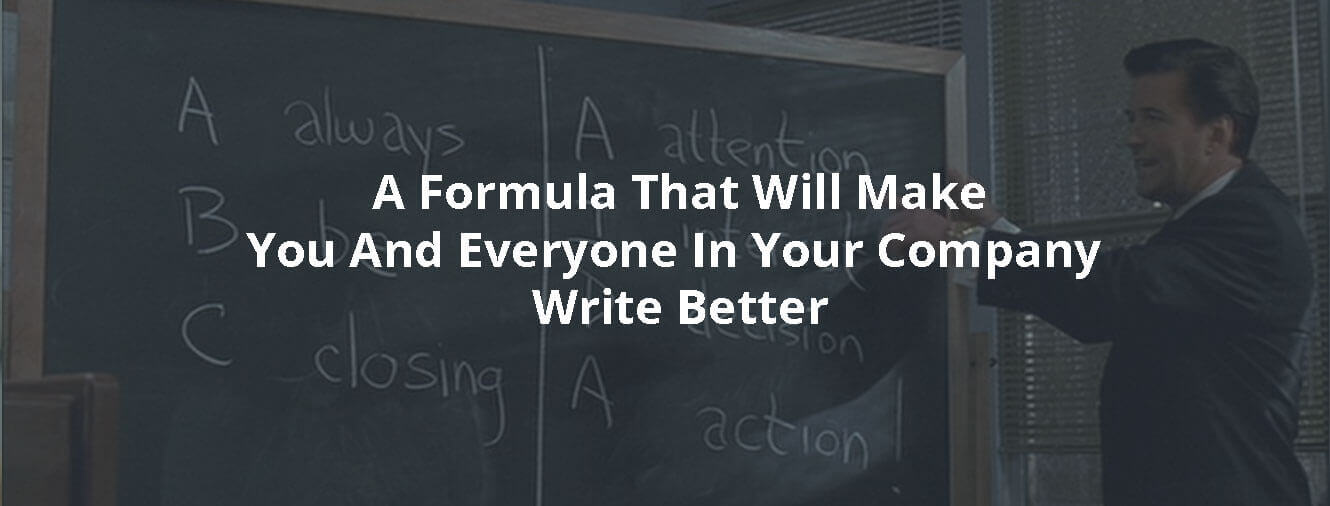
Do you ever wish that there was an easy formula for writing persuasive (web) copy?
What if you could just follow a few rules to writing copy that converts visitors into buyers?
Or just drop a few words into a machine and your seductive copy rolls out at the other side?
Well, at Inbound Rocket we don’t have a robot that automatically generates copy that sells. But we have a formula that will help you write more persuasive copy.
You’ll increase your chances of success if you follow a century-old formula that marketers and salespeople have been using since the 1900s, and it’s still being taught and applied today. It’s been used for various selling situations, from face-to-face sales presentations to printed sales letters, and now, social media.
That’s how good it is.
Much to our surprise, it doesn’t seem to be as widely discussed as you’d expect in the field of content strategy. We can learn a lot about great writing from the art of direct mail copywriting, especially how to engage, persuade, and convert our readers. In this post, we’ll going to show you what this formula is, and how to apply it when writing emails or any other part of your content marketing strategy. It’s called:
The AIDA Copywriting Formula
AIDA stands for:
- Attention: Grab their attention
- Interest: Interest them with interesting facts / uses / stats
- Desire: Make them come to the conclusion, “I WANT THIS”
- Action: Tell them exactly how to buy, and what will happen next.
These four words show the natural progression of an encounter with a prospect that would lead to a sale. In the case of email marketing, this is the progression from the time your subscribers see your email to the time they click on the link in your email. Let’s dive a bit deeper into each step of the formula.
A = Attention
The first step you need to take with any piece of writing is to grab the readers attention. To get their attention, you first have to start with a concept that’s really relevant and timely to the audience that you’re trying to reach. Here are some questions that you can start to ask yourself when you’re in the planning stages to help write an attention-grabber:
- Who is reading this piece? If I had to develop a persona to describe them, what would they look like?
- What is their most pressing problem relating to the topic that I’m writing about? What keeps them up at night or makes them sick to their stomach when they think of a specific issue?
- What kind of solution is this piece offering to their problem? Is it the introduction to an idea that could shift the way that they think about their lives, or a product that they can go out and buy?
- How, specifically, will it solve their issue?
- How does my audience talk about their problems? What are powerful words or concepts that would immediately create resonance?
If you look at these questions they might come over very familiar from our previous blog posts “How to Build Better Buyer Personas to Drive Killer Content (Bonus tip: use Google Analytics)” and “How to Find Your Ideal Customers on Social Media” on how to build Buyer Personas.
Let’s give a concrete example on how this might work. Let’s say you want someone to drink more water. In the attention part of the email you could write something like:
Hey…..you work out right?
Ever see those big muscular dudes at the gym with those comically large jugs of water?
Your headline and your lead paragraph are the two most important areas to capturing your prospect’s attention. Always check these areas first when trying to determine why people aren’t sticking around to read your content.
I = Interest
Once you’ve hooked a reader, it’s time to really help them see how well you understand their problem. This links back to the idea of having a strong profile of who you’re targeting with your products or services before diving into the selling. Specifically, if you take a situation like a health problem, warming up a prospect’s interest starts by showing that you understand their issues.
It’s then time to build your argument or story. For example, you may have done research into the specifics of the condition and know of reputable medical studies that suggest little-known treatments or successful cures. You may have personal experience that you can use to create more of a rapport with your reader. To get back to our example of wanting someone to drink more, you could write something like:
When you work out and tear muscle tissue, it rebuilds itself with amino acids which are fuelled by water in your body. Newbies don’t drink enough so muscles can’t repair.
The key here is to use information, persuasion techniques, and as much proof as you can find to hold the reader’s attention once you’ve captured it. By deepening the connection that you have with the prospect and crafting a piece that informs, educates, and entertains them around one of their most pressing problems, you’ll be well on your way to sparking an emotional reaction.
D = Desire
Now your subscribers are reading your email. Your next task is to build a burning desire for your whatever it is you are offering, whether it’s free information or a product for sale. Without this desire, your readers will discontinue reading, or read without clicking, and then delete or ignore your email.
Sometimes you have to fight a lack of interest. Your readers may recognise a problem and want a solution for it, but not enough to actually do something about it. They’re too lazy or busy or preoccupied.
So in the main body of your copy, you have to make your readers want your offer badly enough to overcome those obstacles.
How do you do this? You have several options:
- Show the features and the benefits: Did you know that people make buying decisions based on emotion but need to rationalise those decisions with facts? You sell on emotion, but you justify a purchase with logic. So give your reader emotion and facts to make them feel good about wanting your offer. Give them the facts, the objective, observable characteristics of your offer. But excite their emotions by going beyond features and pointing out the benefits. These refer to changes in your readers’ condition that occur as a result of consuming your offer. To come back to our example:So if you’re working out 3 times a week…..and keep doing the same, just drink ONE more bottle of water before your workout, you’ll see 30% more muscle gains! JUST from drinking some more water! It’s like getting free muscle without working out more.The best way to identify the benefit of a feature or a set of features is to ask, “So what?” Keep asking until you’ve uncovered the deepest results your readers want.
- Prove it: If you made a big, bold promise or statement, then you have to prove it. Before-and-after photos are powerful proof elements (e.g. showing people who drink more water have more muscle). You can also cite specific results from customers or promise to show a video demonstration. You could even paint a vivid picture of life with your product to whet your readers’ appetite.
- Use social proof: No matter how independent-minded we think we are, we all tend to do what others are doing. This is called “social proof.” An example of social proof is telling readers that 13,489 people have already downloaded your free report. Testimonials are another form of social proof. Make sure the individuals giving the testimonials are as similar to your readers as possible.
- Make it in short supply: The fear of missing out on something increases our desire for it. On the other hand, when something is plentiful and readily available, we tend to take it for granted. This is the basis for using scarcity in sales and marketing. To add scarcity to your offer, make it available for a limited time only. Or, if it’s for a physical product, say that the number of items is limited. Whatever you do, don’t manufacture scarcity. Always tell the truth.
Now your reader desperately wants your offer. Your job isn’t done. Many readers get to this point and then delete the email. Don’t let this happen with your readers!
A = Action
Once you’ve rattled up enough desire to get your prospect thinking about taking action, it’s time to close the deal. This focuses primarily on using a powerful call to action. Calls to action are simple statements that let readers know what you want them to do next: buy a product, sign up for a newsletter, watch a video, or share your tweets for example.
In our example of wanting people to drink more water, we can end up like this:
All you have to do, before you walk into the gym, is chug a half liter of water.
Everything you write should have a call to action – after all, you’re creating a piece of content for a specific reason. So let the reader know what that reason is! Also think about the design aspects of your calls to action: does your layout, button structure, and more support your prospect’s taking action? If it’s at all difficult to figure out how to take the next step, people often won’t.
One final thought: Tell your reader what is going to happen next: The idea here is simple. Anticipate and eliminate the risk that would stop people from doing what you want. Signing up for your newsletter raise privacy concerns? Easy. Just have a clear privacy policy. Are they afraid of parting with their money? Just offer a guarantee. The more that you think about why people wouldn’t take action and offer solutions to those issues, the better positioned you’ll be to make the most of the opportunity.
A great content strategy is one of the most effective initiatives your business can do to help it grow. If you’re ready to try a new strategy to help your content get read more often, keep prospects and readers hooked, and drive them toward action – give AIDA a try. Do you use this framework in any of your marketing? Let us know in the comments below.

